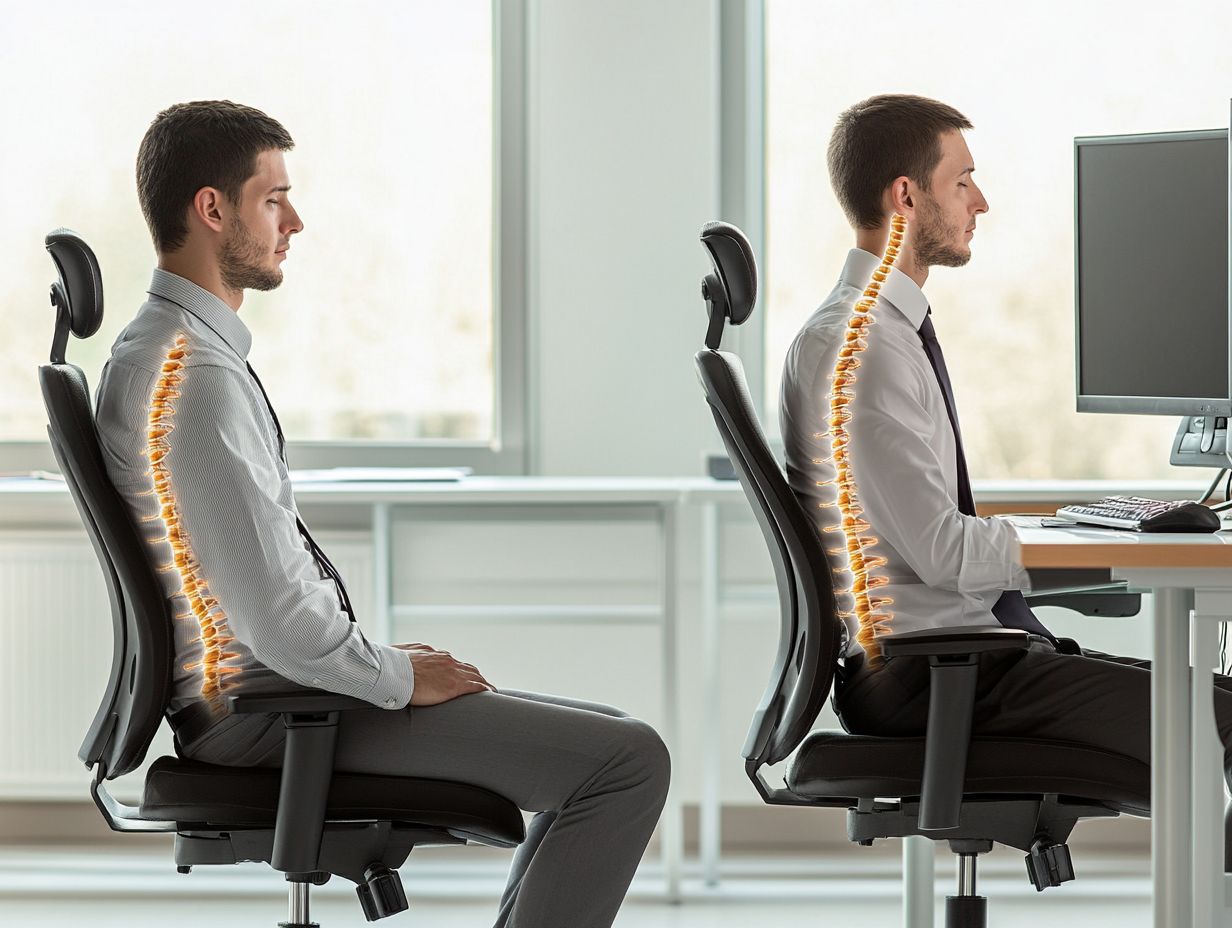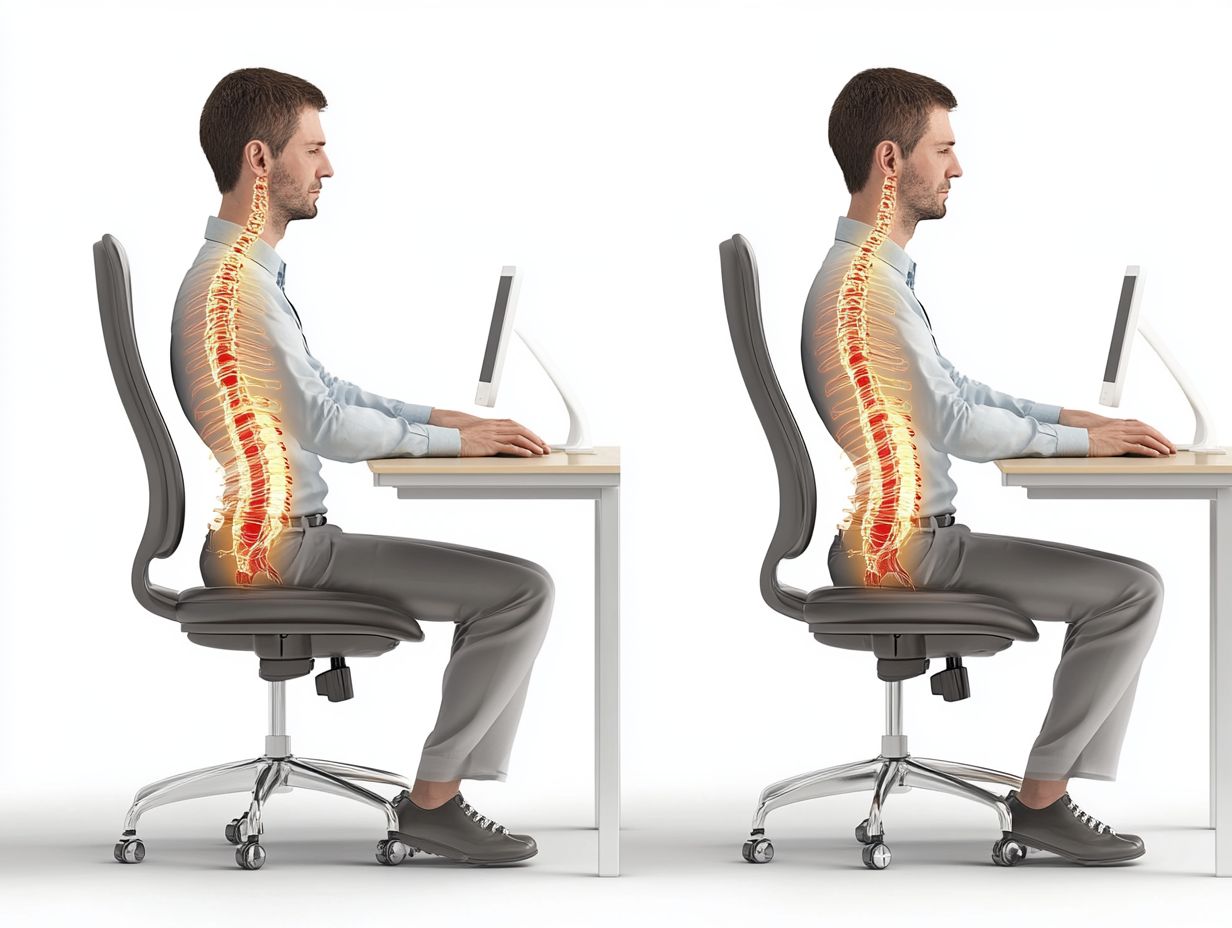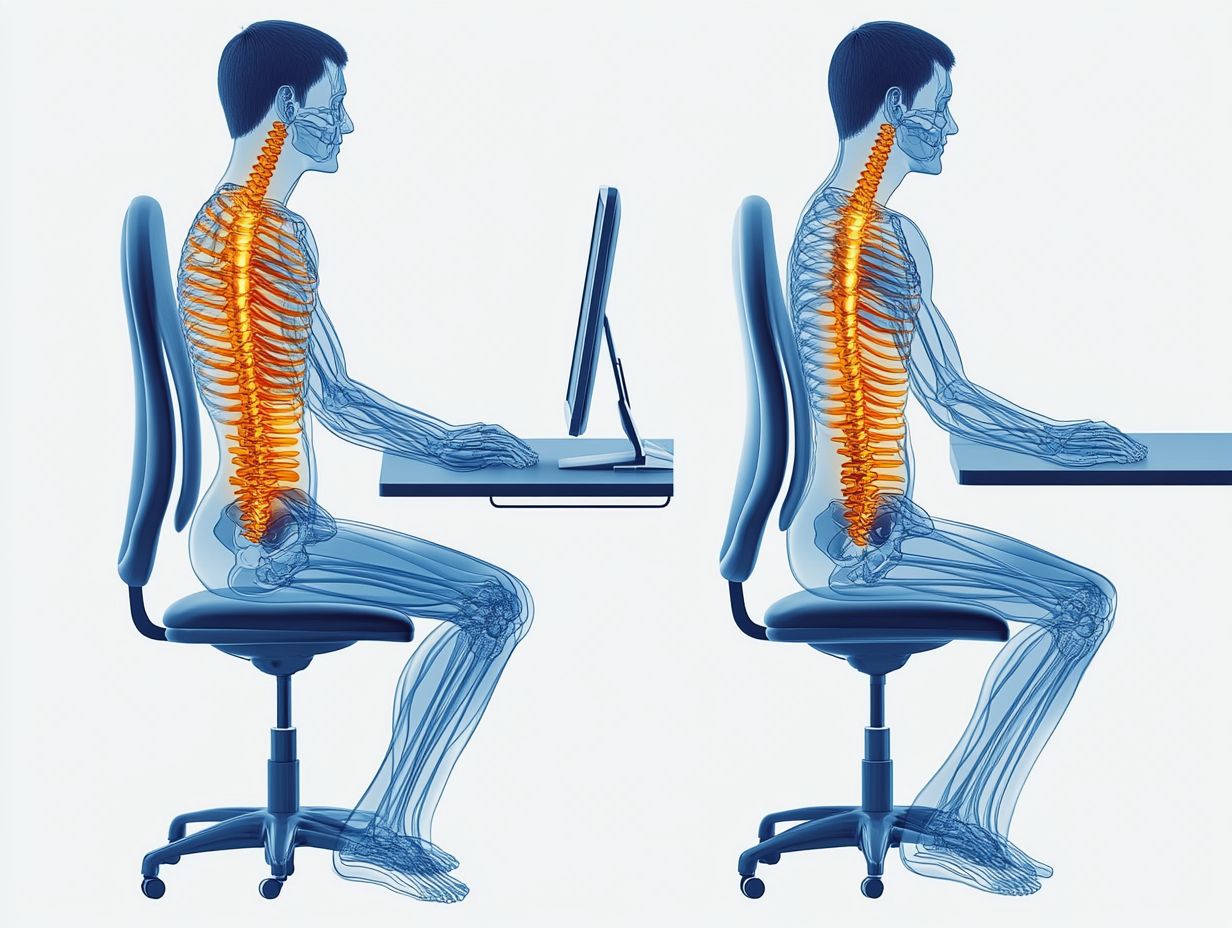The Impact of Poor Posture on Spine Health
Poor posture is more than just a cosmetic concern; it can have profound effects on spine health and overall well-being.
This article explores what constitutes good and poor posture, the common causes behind postural issues, and the serious health risks that can arise from neglecting proper alignment.
It also provides practical strategies for improving posture, such as ergonomic adjustments and targeted exercises.
By understanding and addressing these factors, you can take important steps toward a healthier spine and a more comfortable life.
Understanding Posture

Understanding posture is essential for maintaining not only spinal health but also overall well-being, as it involves the alignment of the body in relation to gravity and the positioning of the spine.
Good posture is characterized by proper spinal alignment, where the intervertebral discs are evenly distributed. Conversely, poor posture often results in slouching, which increases strain on the musculoskeletal system.
Considering the increasing prevalence of sedentary occupations and a culture centered around prolonged sitting, enhancing awareness of posture has become increasingly vital for the prevention of chronic conditions such as back pain and neck strain.
What is Posture?
Posture refers to the position of the body in space and its alignment in relation to gravity, which significantly affects the function of the musculoskeletal system and the health of the spine.
A well-aligned posture is characterized by the natural curvature of the spine, which consists of three primary curves: cervical, thoracic, and lumbar. These curves facilitate shock absorption and weight distribution, thereby promoting efficient movement and minimizing strain on muscles and ligaments.
Central to this system are the intervertebral discs, which serve as shock absorbers between the vertebrae. When posture is misaligned, it can lead to increased pressure on these discs, potentially resulting in pain and degenerative conditions.
Poor posture may contribute to musculoskeletal imbalances, which can manifest as discomfort and reduced mobility. This underscores the importance of maintaining proper alignment for overall health and well-being.
Types of Posture: Good vs. Poor
Good posture is characterized by a balanced alignment that promotes spinal health, whereas poor posture is often indicated by misalignment, resulting in various health complications such as back pain and neck strain.
Individuals who maintain good posture typically present a straight back, relaxed shoulders, and a head that is evenly aligned with the spine. This optimal alignment facilitates effective breathing and circulation, thereby contributing to overall well-being.
Conversely, individuals with poor posture may exhibit slouched positions, hunched shoulders, or a forward-tilted head, which can impose unnecessary strain on muscles and ligaments. For example, prolonged sitting without adequate support may lead to a rounded back and a stiff neck, thereby exerting pressure on spinal discs and causing discomfort.
By prioritizing good posture, individuals can alleviate tension, minimize the risk of chronic pain, and promote proper spinal alignment.
The Causes of Poor Posture
Poor posture frequently results from a combination of factors associated with a sedentary lifestyle, habitual behaviors, and the influence of technology, particularly in the context of today’s digital age where extended screen time is commonplace.
Many individuals, especially those engaged in remote work, tend to develop poor posture habits due to insufficient workplace ergonomics or a lack of awareness regarding proper alignment.
Recognizing these underlying causes is essential for implementing effective posture correction strategies and for preventing chronic conditions that may arise from prolonged physical strain on the body.
Common Factors Contributing to Poor Posture
Common factors contributing to poor posture include sedentary employment, insufficient physical activity, and inadequate workplace ergonomics. These elements can result in misalignment and discomfort within the spine.
When individuals spend extended hours seated at a desk without regular movement, their muscles weaken and become less effective at supporting a healthy spinal alignment. This lack of physical activity further exacerbates the issue, as strong muscles and flexibility are essential for maintaining proper posture. Additionally, poor ergonomic setups, such as ill-fitting chairs or improperly positioned computer screens, compel the body into unnatural positions that can strain the neck and back.
To address these challenges, it is imperative to incorporate regular movement breaks, invest in ergonomic office furnishings, and engage in exercises that strengthen back muscles and enhance overall flexibility. Implementing these adjustments not only improves posture but also fosters a healthier spine, thereby reducing the risk of long-term discomfort and injury.
The Role of Technology in Postural Problems

Technology significantly influences postural issues, often resulting in conditions such as Tech Neck, which arises from excessive screen time and poor ergonomic arrangements, particularly among remote workers.
As dependence on digital devices continues to escalate, many individuals find themselves spending extended periods in a hunched position while engaging with their screens, whether for professional or recreational purposes. A study conducted by the American Chiropractic Association indicates that approximately 65% of Americans experience back pain directly associated with prolonged screen exposure, underscoring the serious repercussions on body mechanics. Furthermore, a survey by the National Institute of Occupational Safety and Health revealed that nearly 35% of remote workers have reported developing musculoskeletal problems due to insufficient workspace ergonomics.
These statistics highlight a growing concern that the contemporary work environment may be contributing to a troubling decline in postural health.
The Health Consequences of Poor Posture
The health consequences of poor posture extend well beyond mere discomfort, significantly impacting spinal health and contributing to chronic conditions such as back pain, neck pain, and various musculoskeletal issues.
When the spine is misaligned, the likelihood of developing conditions such as sciatica, kyphosis, and sacroiliac joint dysfunction rises, highlighting the critical importance of maintaining proper posture habits and awareness.
How Poor Posture Affects Spine Health
Poor posture adversely impacts spinal health by disrupting spinal alignment and placing excessive stress on intervertebral discs, potentially resulting in chronic back pain and a variety of other musculoskeletal disorders.
This misalignment can hinder the spine’s optimal functioning, as the vertebrae may exert uneven pressure on the discs that act as cushions between them. Over time, this persistent stress can lead to herniation or degeneration of these discs, which may result in further complications.
Prolonged poor posture can also alter the spine’s natural curves, contributing to conditions such as scoliosis or lordosis. If these detrimental habits are not addressed promptly, individuals may experience debilitating pain and restricted mobility as they age, underscoring the necessity of maintaining proper posture for long-term spinal health.
Associated Health Risks Beyond the Spine
Beyond spinal health, poor posture is associated with various health risks, including breathing difficulties, increased abdominal pressure, and pelvic floor dysfunction, all of which can significantly impact overall quality of life.
These health concerns extend beyond mere discomfort; they often result in decreased energy levels and chronic fatigue, which can hinder daily activities and overall productivity. Improper alignment may also contribute to tension headaches and adversely affect digestive processes due to impaired stomach function.
Additionally, individuals may experience emotional repercussions, such as increased anxiety and diminished self-esteem, as body language plays a crucial role in perceptions within social and professional contexts.
Addressing posture through mindful practices and ergonomic adjustments can significantly enhance well-being across multiple dimensions, promoting not only physical health but also improved mental clarity and self-confidence.
Identifying Poor Postural Habits
Identifying poor postural habits is an essential step in enhancing spinal health and mitigating associated health risks, as many individuals may remain unaware of their suboptimal posture until it manifests as discomfort or pain.
Common unsupported postural habits include slouching, leaning forward while seated, and failing to utilize adequate lumbar support, all of which can contribute to spinal misalignment and discomfort over time.
Recognizing the signs of poor posture, such as back and neck pain, can serve as a catalyst for necessary posture corrections and promote improved spinal health.
Common Unsupported Postural Habits

Common unsupported postural habits include slouching at a desk, rounding the shoulders, and failing to utilize adequate back support. These behaviors can contribute to chronic back pain and discomfort.
In an office environment, such habits frequently develop as a result of prolonged hours spent in front of a computer screen. For instance, individuals may find themselves leaning forward in their chairs, which places unnecessary stress on the spine and can lead to muscle fatigue.
Resting elbows on hard surfaces without appropriate cushioning can result in tension in the neck and shoulders. Additionally, the inclination to cross legs while seated may cause misalignment of the hips, leading to lower back discomfort.
These postural choices not only impact physical health but can also detract from overall productivity and focus throughout the workday.
Signs You May Have Poor Posture
Signs of poor posture may present as back pain, neck pain, or discomfort while sitting or standing, indicating a need for heightened posture awareness and potential corrective measures.
These signs are often subtle initially, but they can escalate over time if left unaddressed. For example, frequent headaches, shoulder fatigue, or a sensation of <b b="" chest may all be indicative of misalignment.
Individuals may observe their chin protruding forward or excessive rounding of the shoulders, both of which signify misalignment that could lead to discomfort and chronic issues in the future. Early detection is critical, as making conscious adjustments at this stage can prevent the onset of long-term complications such as herniated discs or arthritis.
By routinely assessing their body position during daily activities, individuals can develop healthier posture and enhance their overall well-being.
Strategies for Improving Posture
Implementing effective strategies for improving posture is essential for maintaining spinal health and preventing back pain. These strategies can be broadly categorized into posture tips, exercises, and ergonomic adjustments.
Simple posture tips involve being mindful of alignment while sitting and utilizing appropriate back support. Additionally, exercises such as desk exercises and flexibility routines can strengthen postural muscles and enhance core stability.
By integrating these practices into daily routines, individuals can cultivate good posture habits that contribute to long-term spinal wellness.
Tips for Maintaining Good Posture Throughout the Day
Maintaining proper posture throughout the day necessitates a conscious effort and a commitment to implementing effective strategies that promote spinal alignment and overall well-being.
This involves being mindful of body positioning, whether one is sitting at a desk, standing, or moving around. When seated, it is essential to ensure that the feet are flat on the ground, the back is adequately supported, and the computer screen is positioned at eye level to minimize strain. While standing, individuals should distribute their weight evenly across both feet and keep the shoulders relaxed. Ergonomics plays a pivotal role in these situations by organizing the workspace to support the body’s natural alignment.
It is advisable to regularly remind oneself to monitor posture—consider setting hourly reminders or taking brief breaks to stretch. These minor adjustments can lead to significant improvements over time, enhancing both comfort and productivity.
Exercises to Strengthen Postural Muscles
Engaging in exercises specifically designed to strengthen postural muscles is essential for achieving and maintaining optimal posture, as these exercises enhance core stability and flexibility.
Such routines not only promote balanced body alignment but also play a crucial role in preventing common issues associated with poor posture, including back pain and tension headaches.
Incorporating exercises such as planks, bridges, and bird-dogs effectively targets the muscles that support the spine while simultaneously improving overall strength. Flexibility exercises, including cat-cow stretches and chest openers, further enhance movement quality and facilitate recovery.
By performing these exercises consistently and with proper form, individuals can develop resilience in their postural muscles, fostering greater awareness of their body and promoting long-term health benefits.
Creating an Ergonomic Environment

Establishing an ergonomic environment is crucial for promoting proper posture and mitigating the risk of back pain, especially in workplace settings where individuals often spend extended periods seated at desks.
An appropriate desk configuration, which includes the use of ergonomic office chairs that offer sufficient lumbar support, can enhance spinal alignment and contribute to overall well-being.
By implementing deliberate ergonomic modifications, individuals can design a workspace that fosters good posture and reduces physical strain.
Adjusting Your Workspace for Better Posture
Adjusting the workspace to promote better posture requires careful modifications to the desk setup and the implementation of ergonomic office chairs, ensuring that the body is properly aligned while working.
This entails selecting a chair that provides adequate support for the lower back and adjusting its height so that the feet rest flat on the ground, thereby enhancing stability and comfort. Positioning the monitor at eye level is crucial in preventing neck strain, facilitating a more natural alignment of the head and spine during prolonged periods at the desk.
Additionally, the keyboard should be positioned in such a way that the elbows remain at a 90-degree angle, which minimizes tension in the shoulders and wrists. By implementing these specific adjustments, individuals can cultivate greater posture awareness, significantly contributing to overall spinal health and reducing fatigue as they carry out their daily tasks.
Choosing the Right Chair and Desk Setup
Selecting the appropriate chair and desk configuration is essential for improving posture and preventing discomfort, particularly for individuals who engage in prolonged desk work.
When assessing ergonomic office chairs, it is important to prioritize features such as adjustable seat height, supportive armrests, and breathable materials, as these elements significantly contribute to comfort during extended periods of use. Special attention must be given to lumbar support, ensuring that it aligns with the natural curvature of the spine, which is vital for reducing strain on the lower back.
In conjunction with a thoughtfully designed desk setup that accommodates proper screen height and keyboard placement, individuals can create an environment that promotes good posture. This strategic approach not only enhances productivity but also serves to protect against long-term musculoskeletal disorders.
Summary of Key Points on Posture and Spine Health
The key points regarding posture and spinal health emphasize the critical importance of proper alignment in preventing health risks, including back pain and various chronic conditions.
By comprehending how daily habits influence spinal alignment, individuals can take proactive measures to enhance their overall wellness. The interrelationship between posture and spinal health highlights the necessity for regular assessments of how one sits, stands, and moves throughout the day.
Simple modifications, such as practicing mindful sitting and engaging in strengthening exercises, contribute to a more robust and healthier spine. Cultivating awareness of one’s body mechanics can lead to a reduction in injuries and an improvement in physical performance.
Consequently, prioritizing good posture is not merely a matter of aesthetics; it represents a vital investment in long-term health and vitality.
Encouragement to Implement Positive Changes
Implementing positive changes in posture habits can lead to significant improvements in spinal health and overall well-being, making it essential to take proactive steps starting today.
Small adjustments, such as being mindful of sitting positions, utilizing ergonomic furniture, and taking regular breaks to stretch, can create noticeable improvements over time. Prioritizing these adjustments not only enhances comfort but also reduces the risk of chronic pain and long-term spinal issues.
Consulting with spine specialists can provide valuable insights and personalized recommendations, give the power toing individuals to adopt effective strategies tailored to their unique needs.
By making these manageable changes, individuals can gradually cultivate a more resilient spine, ultimately leading to a vibrant, pain-free lifestyle.
Related Articles for Further Reading
Understanding the significance of posture is essential for maintaining overall well-being and health in daily life.
Proper spinal alignment not only influences physical appearance but also plays a crucial role in preventing chronic pain and discomfort. Poor posture can give rise to various health issues, including tension headaches, fatigue, and even digestive complications.
To gain a deeper understanding of how posture impacts overall health, one may consider exploring informative articles such as:
- ‘The Impact of Ergonomics on Work Performance’
- ‘Effective Techniques for Improving Posture’
These resources can provide valuable insights and strategies. Additionally, literature discussing the relationship between posture and spinal health can further enhance knowledge, guiding individuals on their journey toward improved ergonomic practices.
